Effect of TiO2 Addition on Mortars: Characterization and Photoactivity
Abstract
:1. Introduction
2. Materials and Methods
2.1. Elaboration of Specimens
2.2. Photoactivity Tests
2.3. Characterisation Tests of Building Materials
3. Results
3.1. Mechanical properties
3.2. Physicochemical Properties
3.3. Photoactivity
4. Conclusions
Author Contributions
Funding
Acknowledgments
Conflicts of Interest
References
- Faraldos, M. Guía Práctica de la Fotocatálisis Aplicada a Infraestructuras Urbanas; Congreso Nacional del Medio Ambiente; Asociación Ibérica de Fotocatálisis: Barcelona, Spain, 2012; Available online: http://www.conama2012.conama.org (accessed on 15 May 2016).
- Chiron, M. Air pollution by automobile exhaust and public health. Stud. Surf. Sci. Catal. 1987, 30, 1–10. [Google Scholar]
- Castellote, M.; Ramírez, A.M.; Saeki, Y.; Beeldens, A.; Motohashi, K.; Ohama, Y. Application of Titanium Dioxide Photocatalysis to Construction Materials; Springer: Berlin, Germany, 2011. [Google Scholar]
- Ballari, M.M.; Hunger, M.; Hüsken, G.; Brouwers, H.J.H. NOx photocatalytic degradation employing concrete pavement containing titanium dioxide. Appl. Catal. B Environ. 2010, 95, 245–254. [Google Scholar] [CrossRef]
- Hassan, M.M.; Dylla, H.; Mohammad, L.N.; Rupnow, T. Evaluation of the durability of titanium dioxide photocatalyst coating for concrete pavement. Constr. Build. Mater. 2010, 24, 1456–1461. [Google Scholar] [CrossRef]
- Mendoza, C.; Valle, A.; Castellote, M.; Bahamonde, A.; Faraldos, M. TiO2 and TiO2–SiO2 coated cement: Comparison of mechanic and photocatalytic properties. Appl. Catal. B Environ. 2015, 178, 155–164. [Google Scholar] [CrossRef]
- Chen, J.; Poon, C. Photocatalytic construction and building materials: From fundamentals to applications. Build. Environ. 2009, 44, 1899–1906. [Google Scholar] [CrossRef]
- Lisbona García, L.E. Materiales Fotocatalíticos y Sus Aplicaciones en Construcción. Ph.D. Thesis, Universidad Politécnica de Cataluña, Barcelona, Spain, 25 February 2016. [Google Scholar]
- Sadawy, M.M.; Elsharkawy, E.R. Effect of Nano-TiO2 addition on Mechanical Properties of Concrete and Corrosion Behavior of Reinforcement Bars. IJERA 2016, 6, 61–65. [Google Scholar]
- Folli, A.; Campbell, S.B.; Anderson, J.A.; Macphee, D.E. Role of TiO2 surface hydration on NO oxidation photo-activity. Photochem. Photobiol. A Chem. 2011, 220, 85–93. [Google Scholar] [CrossRef]
- Bygott, C.E.; Maltby, J.E.; Stratton, J.L.; McIntyre, R. Photocatalytic Coatings for the Construction Industry. In International RILEM Symposium on Photocatalysis, Environment and Construction Materials—TDP 2007; Baglioni, P., Casssar, L., Eds.; Rilem: Paris, France, 2007; pp. 251–258. [Google Scholar]
- Ângelo, J.; Andrade, L.; Madeira, L.M.; Mendes, A. An overview of photocatalysis phenomena applied to NOx abatement. J. Environ. Manag. 2013, 129, 522–539. [Google Scholar] [CrossRef]
- Hernández Rodríguez, M.J.; Pulido Melián, E.; González Díaz, O.; Araña, J.; Macías, M.; González Orive, A.; Doña Rodríguez, J.M. Comparison of supported TiO2 catalysts in the photocatalytic degradation of NOx. J. Mol. Catal. A Chem. 2016, 413, 56–66. [Google Scholar] [CrossRef]
- Zabek, P.; Eberl, J.; Kisch, H. On the origin of visible light activity in carbon-modified titania. Photochem. Photobiol. Sci. 2009, 8, 264–269. [Google Scholar] [CrossRef]
- Sanchez-Segado, S.; Makanyire, T.; Escudero-Castejon, L.; Hara, Y.; Jha, A. Reclamation of reactive metal oxides from complex minerals using alkali roasting and leaching—An improved approach to process engineering. Green. Chem. 2015, 17, 2059–2208. [Google Scholar] [CrossRef]
- Robotti, M.; Dosta, S.; Fernández-Rodríguez, C.; Hernández-Rodríguez, M.J.; Cano, I.G.; Pulido Melián, E.; Guilemany, J.M. Photocatalytic abatement of NOx by C-TiO2/polymer composite coatings obtained by low pressure cold gas spraying. Appl. Surf. Sci. 2016, 362, 274–280. [Google Scholar] [CrossRef]
- Lucas, S.S.; Ferreira, V.M.; Barroso de Aguiar, J.L. Incorporation of titanium dioxide nanoparticles in mortars-Influence of microstructure in the hardened state properties and photocatalytic activity. Cem. Concr. Res. 2013, 43, 112–120. [Google Scholar] [CrossRef]
- Chen, X.; Wu, S.; Zhou, J. Influence of porosity on compressive and tensile strength of cement. Constr. Build Mater. 2013, 40, 869–874. [Google Scholar] [CrossRef]
- Pérez Nicolás, M.; Navarro Blasco, I.; Fernández, J.M.; Álvarez, J.I. The effect of TiO2 doped photocatalytic nano-additives on the hydration and microstructure of Portland and high alumina cements. Nanomaterials 2017, 7, 329. [Google Scholar] [CrossRef]
- Pipilikaki, P.; Beazi-Katsioti, M. The assessment of porosity and pore size distribution of limestone Portland cement pastes. Constr. Build. Mater. 2009, 23, 1966–1970. [Google Scholar] [CrossRef]
- Kuo, W.T.; Lin, K.L.; Chang, W.C.; Luo, H.L. Effects of nano-materials on properties of waterworks sludge ash cement paste. J. Ind. Eng. Chem. 2006, 12, 702–709. [Google Scholar]
- Nazari, A.; Riahi, S.; Fatemeh Shamekhi, S.; Khademno, A. Improvement the mechanical properties of the cementitious composite by using TiO2 nanoparticles. J. Am. Sci. 2010, 6, 98–101. [Google Scholar]
- Pérez-Nicolás, M.; Balbuena, J.; Cruz-Yusta, M.; Sánchez, L.; Navarro-Blasco, I.; Fernández, J.M.; Alvarez, J.I. Photocatalytic NOx abatement by calcium aluminate cements modified with TiO2: Improved NO2 conversion. Cem Concr. Res. 2015, 70, 67–76. [Google Scholar] [CrossRef]
- Chen, K.Y.; Hills, C.D.; Tyrer, M.; Slipper, I.; Shen, H.G.; Brough, A. Characterisation of products of tricalcium silicate hydration in the presence of heavy metals. J. Hazard. Mater. 2007, 147, 817–825. [Google Scholar] [CrossRef]
- Pompeu Correa, P. Estudio Mediante Trazadores de la Disolución de Hidratos de Cemento Portland y Sus Implicaciones en la Durabilidad e Impacto Ambiental de los Materiales de Construcción. Ph.D. Thesis, Universitat Politécnica de Catalunya, Bracelona, Spain, July 2010. [Google Scholar]
- Andrade Dantas, S.R.; Serafini, R.; de Oliveira Romano, R.C.; Vittorino, F.; Loh, K. Influence of the nano TiO2 dispersion procedure on fresh and hardened rendering mortar properties. Constr. Build. Mater. 2019, 215, 544–556. [Google Scholar] [CrossRef]
- Cassar, L. Photocatalysis of cementitious materials: Clean buildings and clean air. MRS Bull. 2004, 29, 328–331. [Google Scholar] [CrossRef]
- Shen, S.; Burton, M.; Jobson, B.; Haselbach, L. Pervious concrete with titanium dioxide as a photocatalyst compound for a greener urban road environment. Constr. Build. Mater. 2012, 35, 874–883. [Google Scholar] [CrossRef]
- Paz, Y. Application of TiO2 photocatalysis for air treatment: Patents’ overview. Appl. Catal. B Environ. 2010, 99, 448–460. [Google Scholar] [CrossRef]
- Xie, N. Mechanical and Environmental Resistance of Nanoparticle-Reinforced Pavement Materials. In Innovative Developments of Advanced Multifunctional Nanocomposites in Civil and Structural Engineering, 1st ed.; Kenneth Loh, K., Nagarajaiah, S., Eds.; Woodhead Publishing: Sawston, UK, 2016; pp. 217–246. [Google Scholar]
- Feng, D.; Xie, N.; Gong, C.; Leng, Z.; Xiao, H.; Li, H.; Shi, X. Portland cement paste modified by TiO2 nanoparticles: A microstructure perspective. Ind. Eng. Chem. Res. 2013, 52, 11575–11582. [Google Scholar] [CrossRef]
- Folli, A.; Pochard, I.; Nonat, A.; Jakobsen, U.H.; Shepherd, A.M.; Macphee, D.E. Engineering photocatalytic cements: Understanding TiO2 surface chemistry to control and modulate photocatalytic performances. J. Am. Ceram. Soc. 2010, 93, 3360–3369. [Google Scholar] [CrossRef]
- Rhee, I.; Lee, J.S.; Kim, J.B.; Kim, J.H. Nitrogen oxides mitigation efficiency of cementitious materials incorporated with TiO2. Materials 2018, 11, 877. [Google Scholar] [CrossRef]
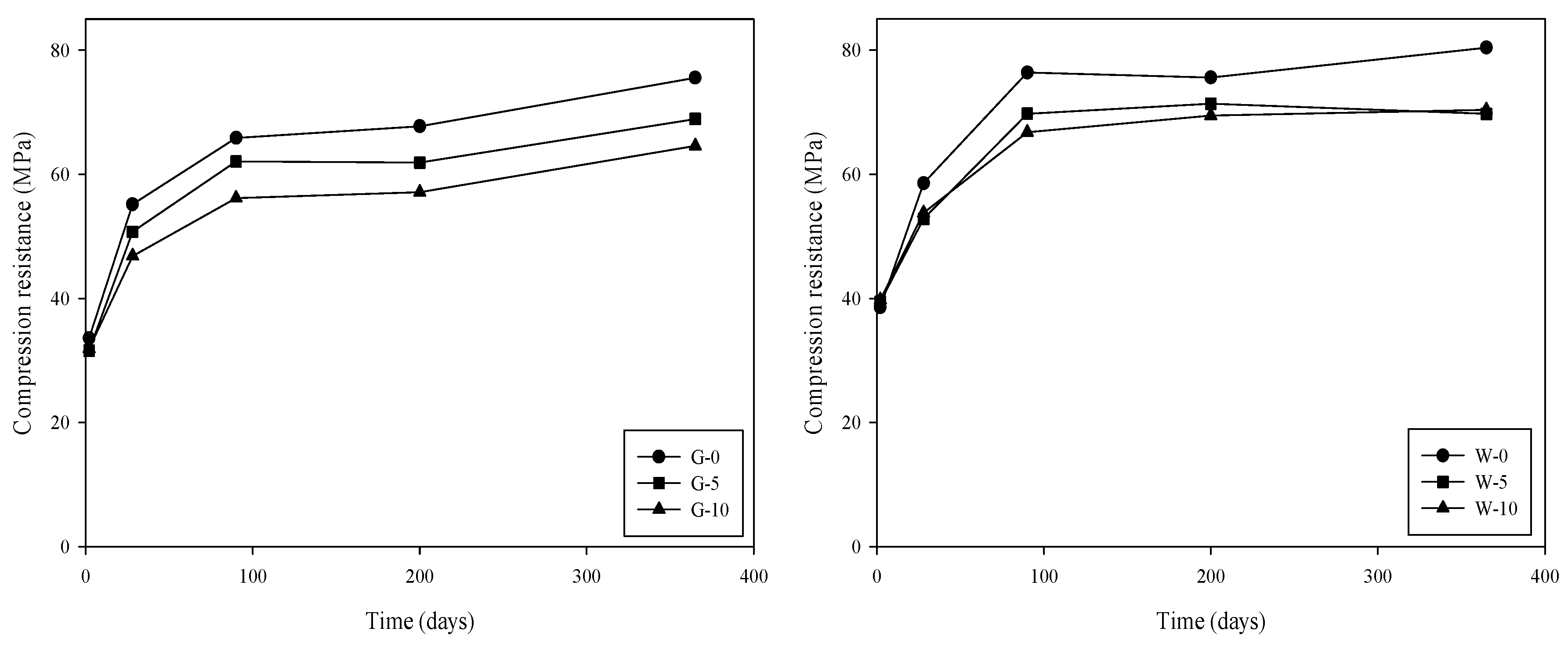

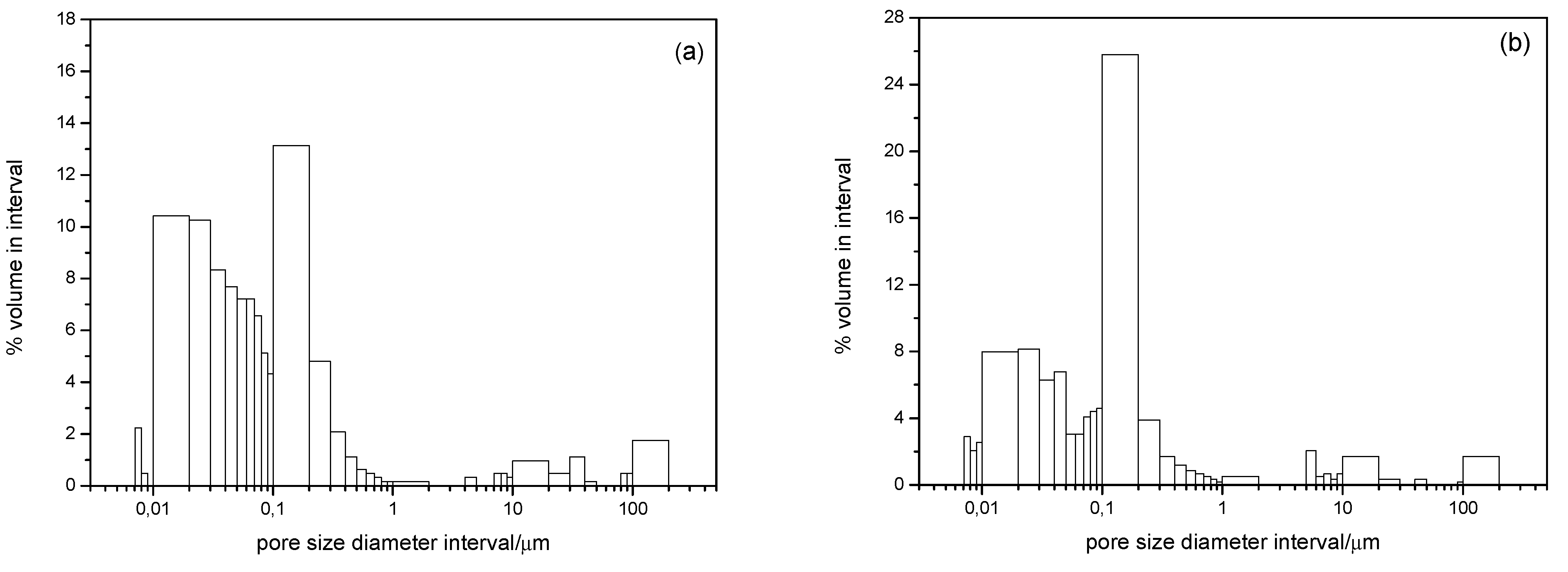
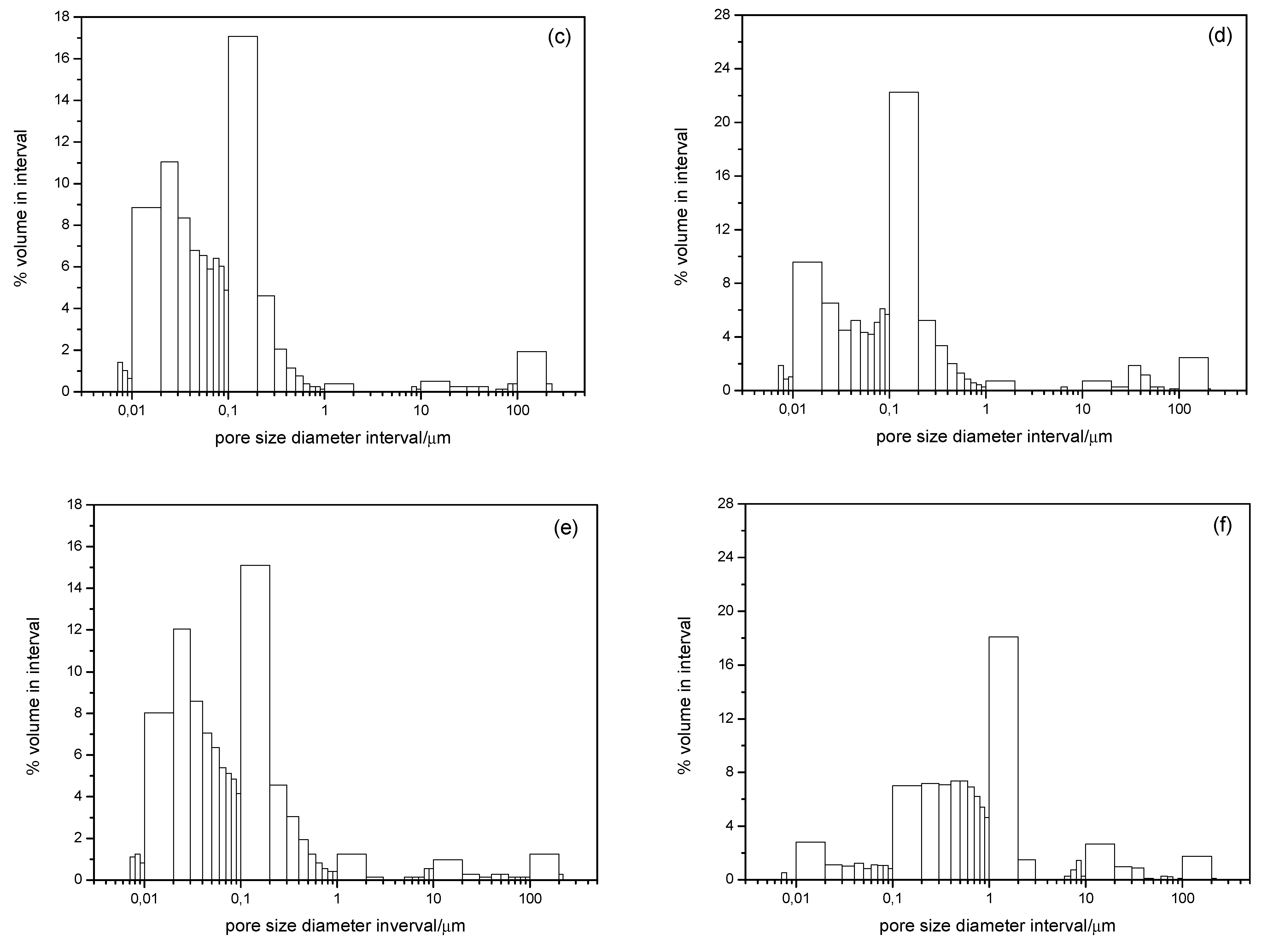
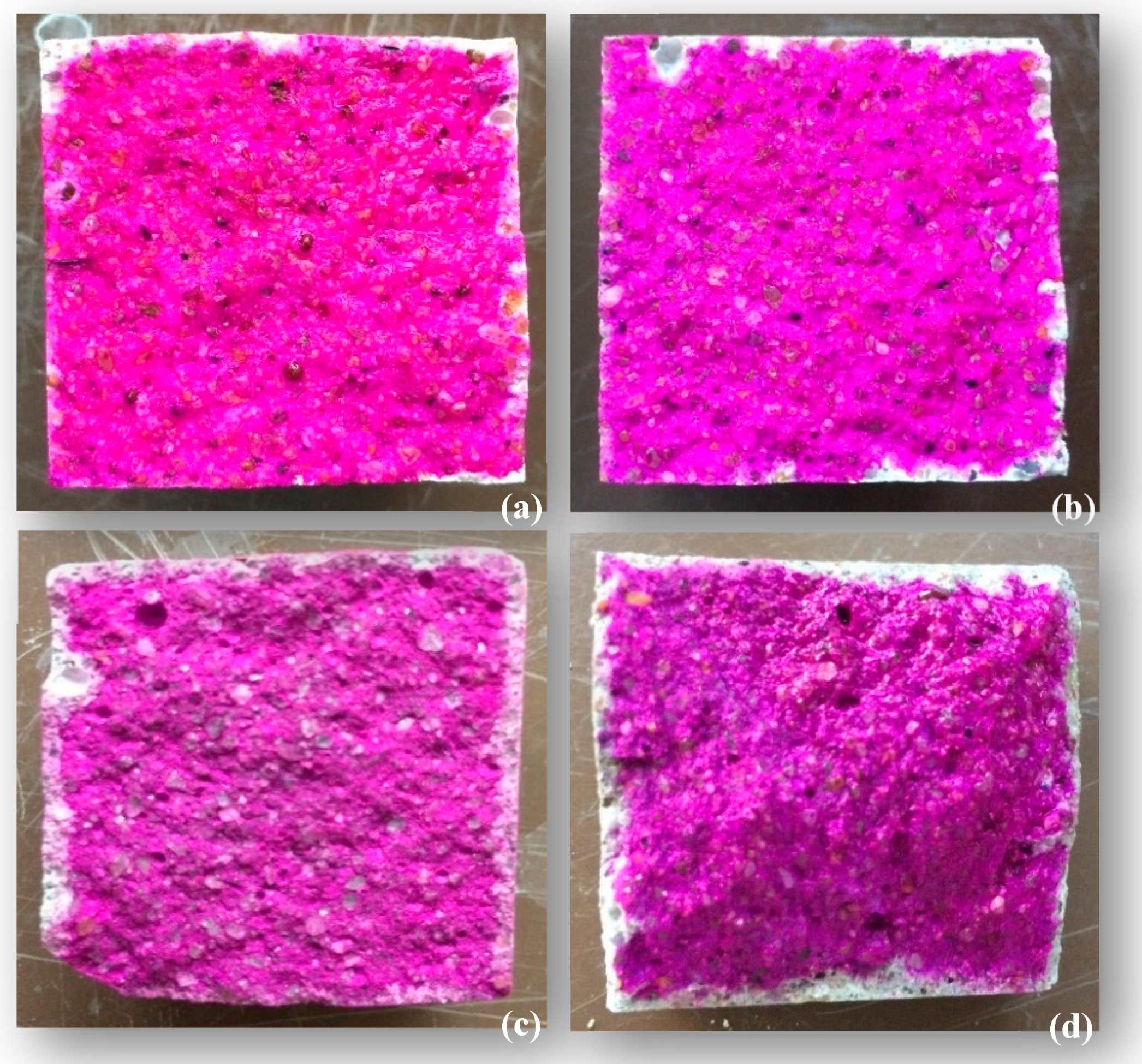
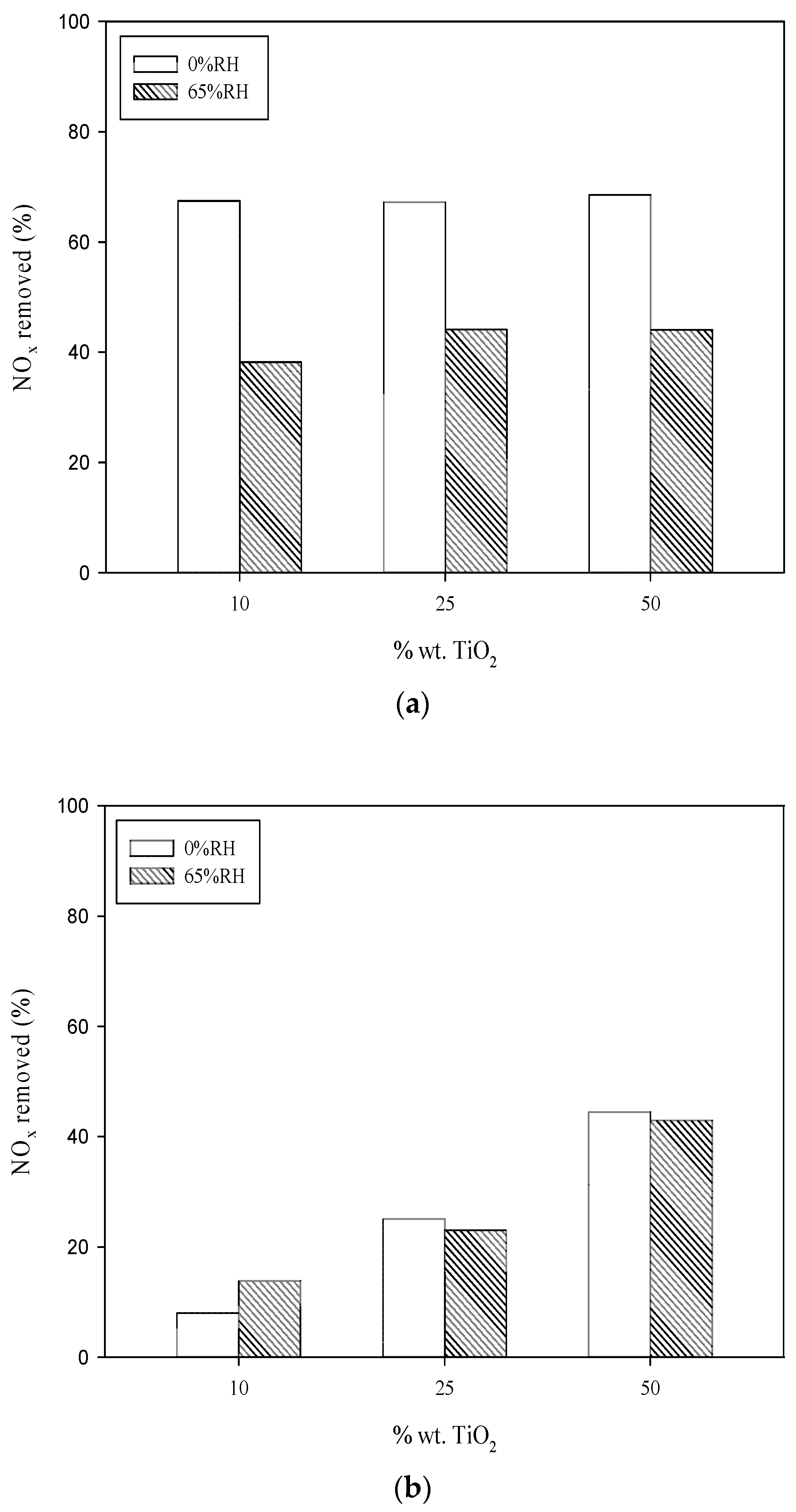
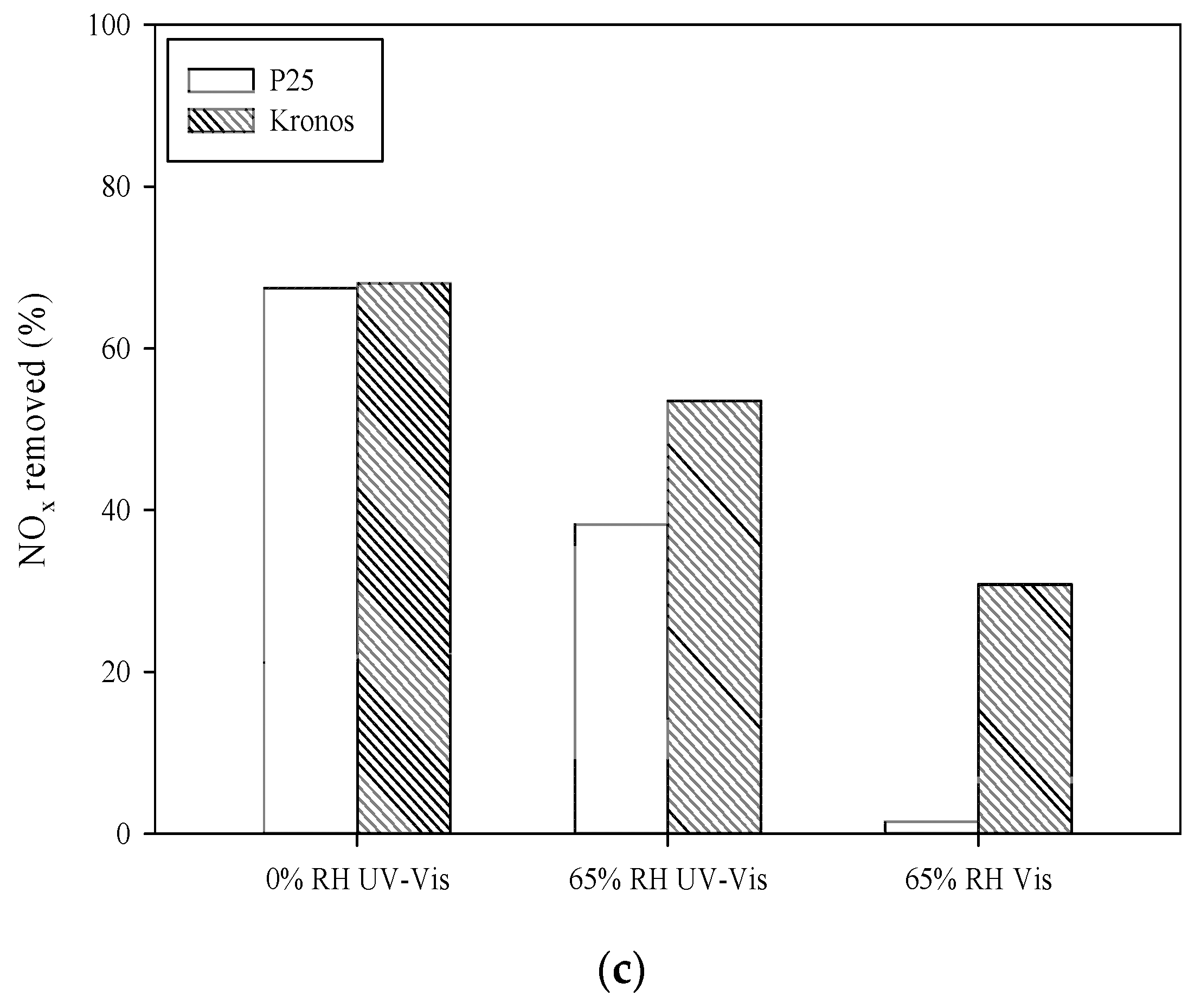
| days | G | G-5 | G-10 | W | W-5 | W-10 |
|---|---|---|---|---|---|---|
| 2 | 6.33 | 6.13 | 5.61 | 6.42 | 6.08 | 6.06 |
| 28 | 9.05 | 8.21 | 8.29 | 8.65 | 8.70 | 7.53 |
| 90 | 10.40 | 9.41 | 9.41 | 9.95 | 9.61 | 8.88 |
| 200 | 11.20 | 9.86 | 9.81 | 10.32 | 10.18 | 10.28 |
| 365 | 12.26 | 11.20 | 10.91 | 12.01 | 10.69 | 10.32 |
| Sample | Initial Setting Time | Final Setting Time | Setting Time |
|---|---|---|---|
| W | 2 h 51 min | 3 h 41 min | 50 min |
| W-5 | 1 h 52 min | 2 h 32 min | 40 min |
| W-10 | - | - | - |
| G | 2 h 45 min | 4 h 36 min | 1 h 51 min |
| G-5 | 1 h 52 min | 3 h 22 min | 1 h 30 min |
| G-10 | 1 h 40 min | 2 h 30 min | 50 min |
| Samples | %Hydration in the Mortar | %Portlandite (%Ch) in the Cement |
|---|---|---|
| W | 3.31 | 32.9 |
| W-5 | 2.96 | 30.9 |
| W-10 | 2.47 | 29.7 |
| G | 2.91 | 29.3 |
| G-5 | 3.07 | 29.4 |
| G-10 | 3.06 | 30.0 |
| Samples | Total Porosity (% vol.) | Mean Pore Size (µm) |
|---|---|---|
| G | 7.14 | 4.02 × 10−2 |
| G-5 | 12.20 | 4.17 × 10−2 |
| G-10 | 11.58 | 4.20 × 10−2 |
| W | 7.26 | 3.88 × 10−2 |
| W-5 | 9.39 | 4.55 × 10−2 |
| W-10 | 10.12 | 1.61 × 10−1 |
| Samples | 0% RH | 65% RH |
|---|---|---|
| G | 5.61 | 11.84 |
| G-5 | 15.02 | 14.24 |
| G-10 | 23.34 | 20.90 |
| W | 0.00 | 1.53 |
| W-5 | 9.34 | 3.57 |
| W-10 | 12.53 | 12.98 |
© 2019 by the authors. Licensee MDPI, Basel, Switzerland. This article is an open access article distributed under the terms and conditions of the Creative Commons Attribution (CC BY) license (http://creativecommons.org/licenses/by/4.0/).
Share and Cite
Hernández-Rodríguez, M.J.; Santana Rodríguez, R.; Darias, R.; González Díaz, O.; Pérez Luzardo, J.M.; Doña Rodríguez, J.M.; Pulido Melián, E. Effect of TiO2 Addition on Mortars: Characterization and Photoactivity. Appl. Sci. 2019, 9, 2598. https://doi.org/10.3390/app9132598
Hernández-Rodríguez MJ, Santana Rodríguez R, Darias R, González Díaz O, Pérez Luzardo JM, Doña Rodríguez JM, Pulido Melián E. Effect of TiO2 Addition on Mortars: Characterization and Photoactivity. Applied Sciences. 2019; 9(13):2598. https://doi.org/10.3390/app9132598
Chicago/Turabian StyleHernández-Rodríguez, M. J., R. Santana Rodríguez, R. Darias, O. González Díaz, J. M. Pérez Luzardo, J. M. Doña Rodríguez, and E. Pulido Melián. 2019. "Effect of TiO2 Addition on Mortars: Characterization and Photoactivity" Applied Sciences 9, no. 13: 2598. https://doi.org/10.3390/app9132598





